Breaking News 148
NASA Is Crashing a Spacecraft into an Asteroid Today,
NASA’s Planetary Defense mission DART (The Double Asteroid Redirection Test) will impact asteroid Dimorphos Today (September 26) at 19:14 ET.
NASA is right on track to crash a spacecraft into an asteroid in what is the first planetary defence mission attempt in the history of mankind. DART (The Double Asteroid Redirection Test) may evoke memories of Hollywood movies such as Armageddon or Deep Impact, but this is very real and is actually part of the US space agency’s first planetary defence test. It is worth mentioning, however, that the asteroid that is about to be struck by DART poses no threat to our planet. In essence, the DART mission is a scientific experiment that, if successful, could help scientists develop better and stronger spacecraft that one day, should it be necessary, deflect an asteroid on a collision course to Earth.
Launched in November 2021, the Double Asteroid Redirection Test travelled for nearly a year to finally catch up to the small asteroid Dimorphos, which orbits a larger asteroid dubbed Didymos. Didymos and Dimorphos have also made their closest approach to Earth in years and are currently passing as close as 10.8 million kilometres from our planet. The impact will take place today (September 26) at 19:14 ET and can be seen live on NASA TV and the agency’s YouTube channel. The spacecraft performed its final approach manoeuvre towards the target asteroid yesterday and is not autonomously guiding itself towards Dimorphous.
As part of their partnership with several South African observatories, the Virtual Telescope Project will display the asteroid’s trajectory in real-time at the time of its scheduled impact. The collision will likely slow Dimorphos and trim its orbit around its companion asteroid. Even though the asteroid is small, NASA says that observers will be able to detect changes in the brightness of the asteroid caused by the impact.
Observations of the change in the orbital period will be made through telescopes located on Earth. Seventy-three seconds is the minimum change required for the mission to be considered successful. The DART technique may be useful in altering the trajectory of asteroid years or decades before it threatens the Earth.
Queen Elizabeth II has died
Queen Elizabeth II, the UK’s longest-serving monarch, has died at Balmoral aged 96, after reigning for 70 years.
She died peacefully on Thursday afternoon at her Scottish estate, where she had spent much of the summer.
The Queen came to the throne in 1952 and witnessed enormous social change.
Her son King Charles III said the death of his beloved mother was a “moment of great sadness” for him and his family and that her loss would be “deeply felt” around the world.
He said: “We mourn profoundly the passing of a cherished sovereign and a much-loved mother.
“I know her loss will be deeply felt throughout the country, the realms and the Commonwealth, and by countless people around the world.”
During the coming period of mourning, he said he and his family would be “comforted and sustained by our knowledge of the respect and deep affection in which the Queen was so widely held”.
The King and his wife, Camilla, now Queen Consort, will return to London on Friday, Buckingham Palace said. He is expected to address the nation on Friday.
Senior royals had gathered at Balmoral after the Queen’s doctors became concerned about her health earlier in the day.
All the Queen’s children travelled to Balmoral, near Aberdeen, after doctors placed the Queen under medical supervision.
Her grandson and now heir to the throne, Prince William, and his brother, Prince Harry, also gathered there.
Prime Minister Liz Truss, who was appointed by the Queen on Tuesday, said the monarch was the rock on which modern Britain was built, who had “provided us with the stability and strength that we needed”.
Speaking about the new King, she said: “We offer him our loyalty and devotion, just as his mother devoted so much, to so many, for so long.
“And with the passing of the second Elizabethan age, we usher in a new era in the magnificent history of our great country, exactly as Her Majesty would have wished, by saying the words ‘God save the King’.”
The Archbishop of Canterbury Justin Welby – spiritual leader to the Church of England of which the monarch is supreme governor – expressed his “profound sadness”.
He said his “prayers are with the King and the Royal Family”.
Queen Elizabeth II’s tenure as head of state spanned post-war austerity, the transition from empire to Commonwealth, the end of the Cold War and the UK’s entry into – and withdrawal from – the European Union.
Her reign spanned 15 prime ministers starting with Winston Churchill, born in 1874, and including Ms Truss, born 101 years later in 1975.
She held weekly audiences with her prime minister throughout her reign.
At Buckingham Palace in London, crowds awaiting updates on the Queen’s condition began crying as they heard of her death.
The union flag on top of the palace was lowered to half-mast at 18:30 BST and an official notice announcing the death was posted outside.
On the Queen’s death, Prince William and his wife, Catherine, became the Duke and Duchess of Cambridge and Cornwall.
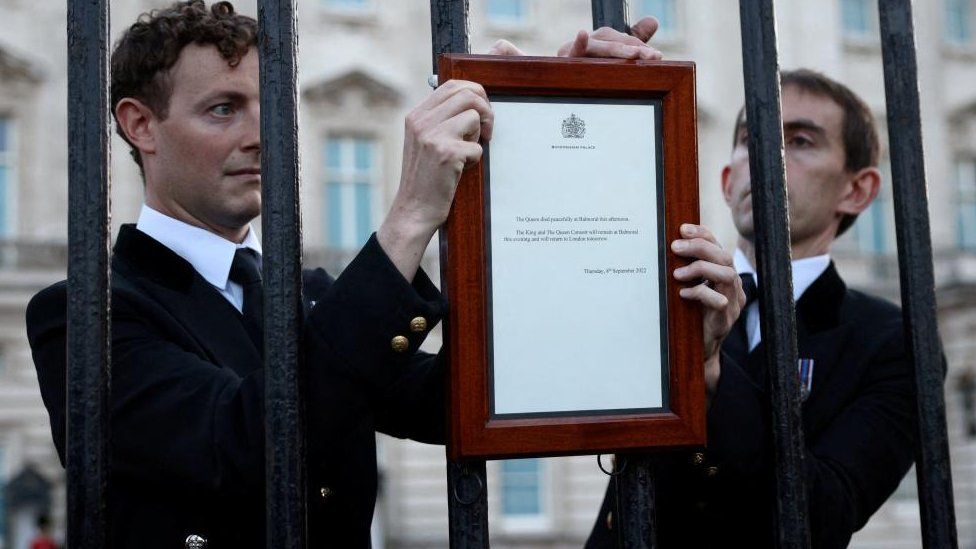
The Queen was born Elizabeth Alexandra Mary Windsor, in Mayfair, London, on 21 April 1926.
Few could have foreseen she would become monarch but in December 1936 her uncle, Edward VIII, abdicated from the throne to marry the twice-divorced American, Wallis Simpson.
Elizabeth’s father became King George VI and, at age 10, Lilibet, as she was known in the family, became heir to the throne.
Within three years, Britain was at war with Nazi Germany. Elizabeth and her younger sister, Princess Margaret, spent much of wartime at Windsor Castle after their parents rejected suggestions they be evacuated to Canada.
After turning 18, Elizabeth spent five months with the Auxiliary Territorial Service and learned basic motor mechanic and driving skills. “I began to understand the esprit de corps that flourishes in the face of adversity,” she recalled later.
Through the war, she exchanged letters with her third cousin, Philip, Prince of Greece, who was serving in the Royal Navy. Their romance blossomed and the couple married at Westminster Abbey on 20 November 1947, with the prince taking the title of Duke of Edinburgh.
She would later describe him as “my strength and stay” through 74 years of marriage, before his death in 2021, aged 99.
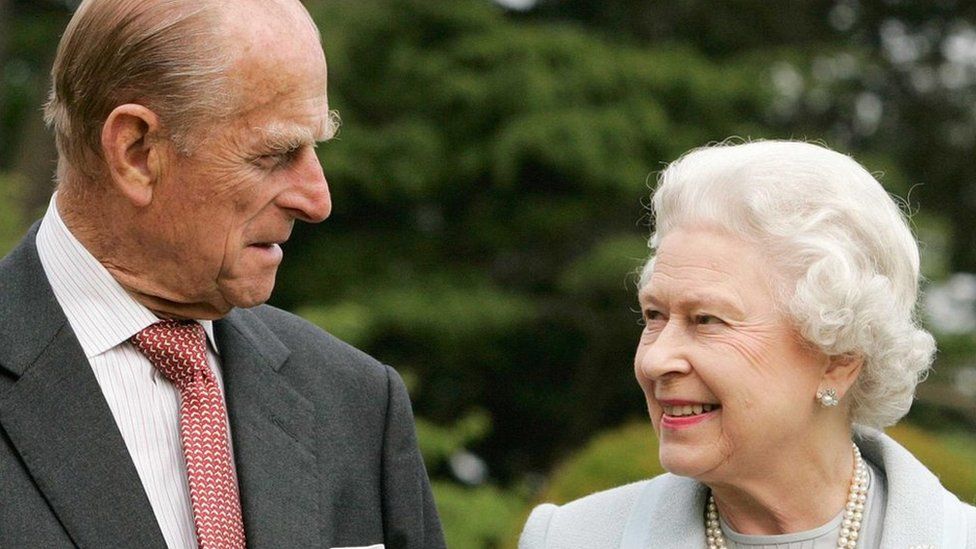
Their first son, Charles, was born in 1948, followed by Princess Anne, in 1950, Prince Andrew, in 1960, and Prince Edward, in 1964. Between them, they gave their parents eight grandchildren and 12 great-grandchildren.
Princess Elizabeth was in Kenya in 1952, representing the ailing King, when Philip broke the news that her father had died. She immediately returned to London as the new Queen.
“It was all a very sudden kind of taking on and making the best job you can,” she later recalled.
Elizabeth was crowned at Westminster Abbey on 2 June 1953, aged 27, in front of a then-record TV audience estimated at more than 20 million people.
Subsequent decades would see great change, with the end of the British Empire overseas and the Swinging ’60s sweeping away social norms at home.
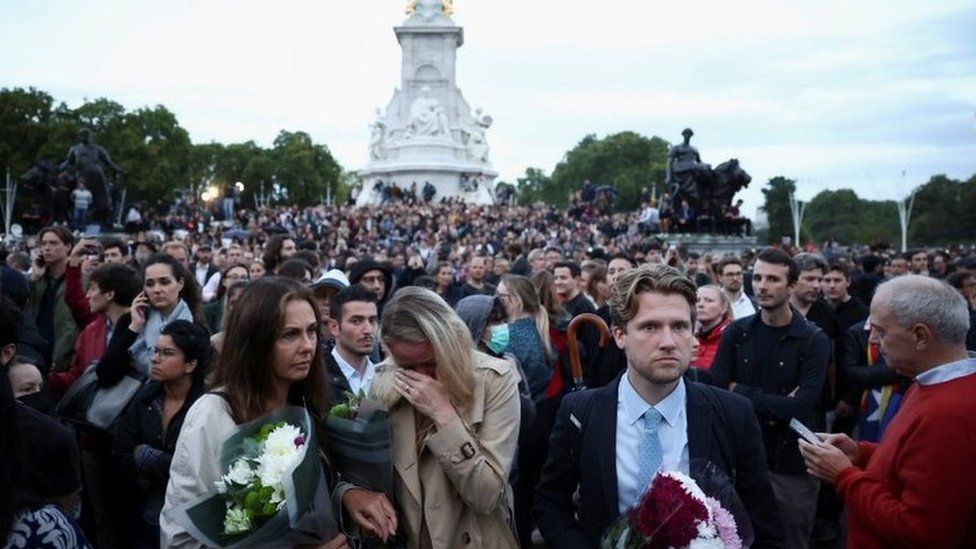
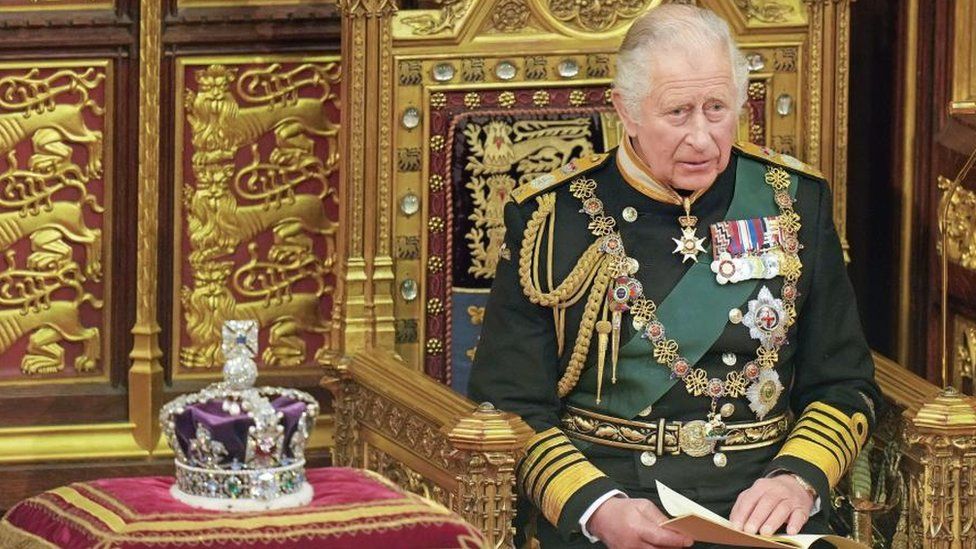
Elizabeth reformed the monarchy for this less deferential age, engaging with the public through walkabouts, royal visits and attendance at public events.
Her commitment to the Commonwealth was a constant – she visited every Commonwealth country at least once.
But there were periods of private and public pain.
In 1992, the Queen’s “annus horribilis”, fire devastated Windsor Castle – a private residence as well as working palace – and three of her children’s marriages broke down.
After the death of Diana, Princess of Wales, in a car accident in Paris in 1997, the Queen drew criticism for appearing reluctant to respond publicly.
There were questions about the monarchy’s relevance in modern society.
“No institution… should expect to be free from the scrutiny of those who give it their loyalty and support, not to mention those who don’t,” she acknowledged.
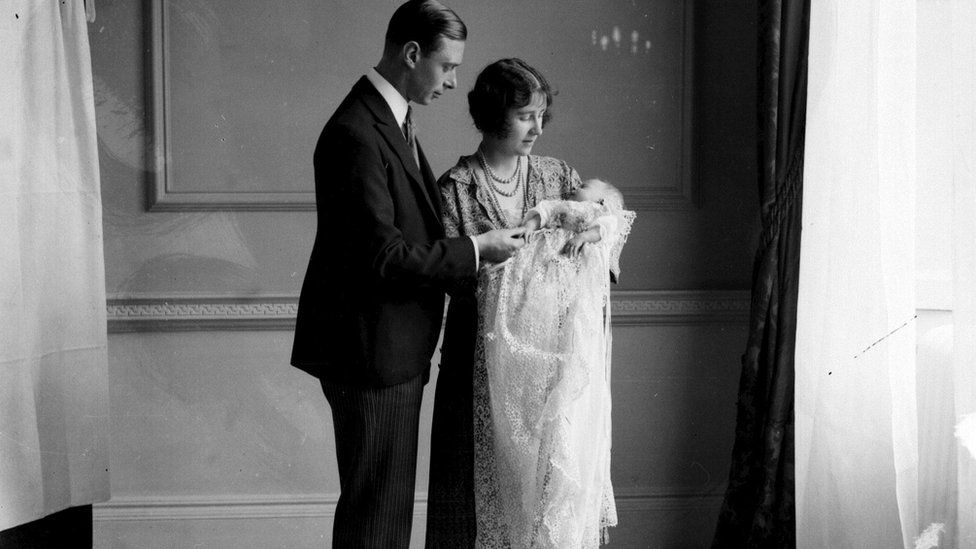
As a 21-year-old princess, Elizabeth had vowed to devote her life to service.
Reflecting on those words decades later, during her Silver Jubilee in 1977, she declared: “Although that vow was made in my salad days, when I was green in judgment, I do not regret nor retract one word of it.”
That same commitment to serving was made 45 years later in a thank you letter to the nation on the weekend of her Platinum Jubilee in June.
The milestone was celebrated with a mix of state ceremonies and a colourful festival of all things British, as well as lively street parties.
Although the Queen’s health kept her from some events, she said: “My heart has been with you all.”
In a moment met with cheers from huge crowds in the Mall, she was joined by three generations of her family on the Buckingham Palace balcony for the finale of a pageant.
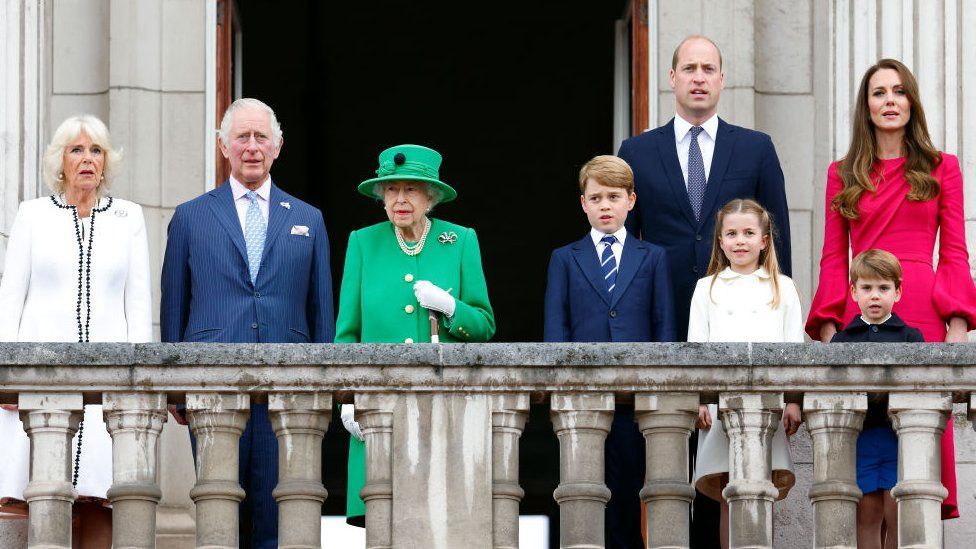
King Charles, aged 73, becomes head of state in 14 Commonwealth realms.
He and his wife, Camilla, are at Balmoral alongside his siblings, Princess Anne, and Princes Andrew and Edward.
They are accompanied by Edward’s wife, Sophie, as well as Princes William and Harry.
William’s wife, Catherine, remained at Windsor with their children – George, Charlotte and Louis – as it has been their first full day at a new school.

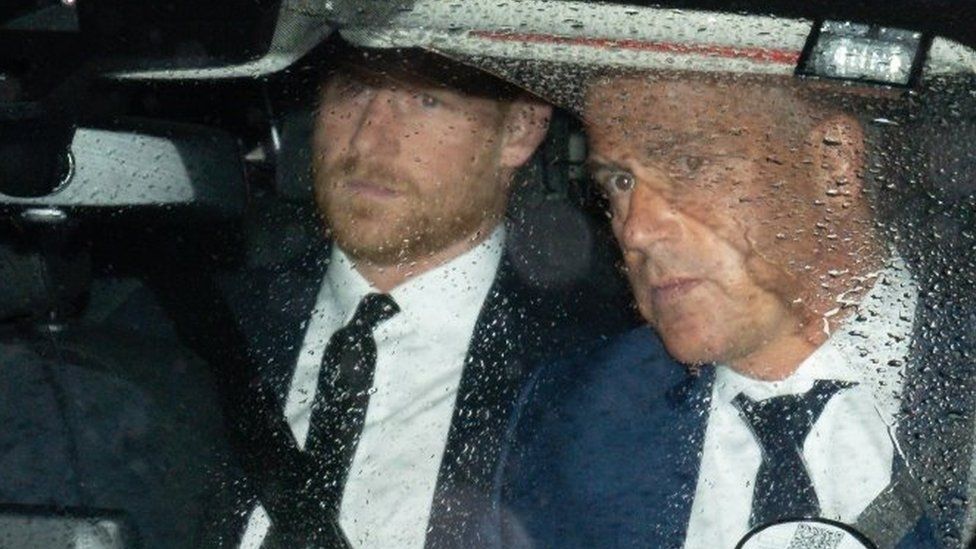
The Royal Family has now entered a period of mourning. In the coming days, much of national life will be put on hold.
Official engagements will be cancelled and union flags will be flown at half-mast on royal residences, government buildings, across the Armed Forces and on UK posts overseas.
Members of Parliament will pay tribute to the Queen and take an oath to King Charles.
There will be church bells tolling and gun salutes as local and national organisations and charities organise ways to pay their respects, with commemorative events and books of condolence.
A state funeral for the Queen is expected in the next two weeks.
Foreign leaders have paid tribute to the Queen, with US President Joe Biden recalling how she stood in solidarity with the US in their “darkest days” after the 9/11 terrorist attacks.
To France’s president, Emmanuel Macron, she was a “kind-hearted Queen” and “friend of France”.
For Justin Trudeau, Canada’s prime minister, the Queen was a constant in Canadians’ lives and one of his “favourite people in the world”.
Monkeypox: CDC says US leads globally in most known cases
More than 3,800 monkeypox cases have been reported in the US, the most of any country around the globe, government health data shows.
The rising number of cases has reportedly prompted the Biden administration to mull declaring a national health emergency. The virus has already been classified as a global health emergency by the World Health Organization (WHO). To date, more than 18,000 cases have been reported in 75 countries. According to data published online by the US Centers for Disease Control and Prevention (CDC), as of 25 July there were 3,846 confirmed or suspected monkeypox cases in the US. The figure – which comes amid expanded testing in addition to the growing outbreak of the virus – is now ahead of that of Spain, where 3,105 cases have so far been reported.
The two other countries with the highest number of infections, Germany and the UK, have reported 2,352 and 2,208 cases, respectively. With cases in the US rising, the Washington Post on 25 July reported that the Biden administration was considering declaring a public health emergency. The measure would allow the government to use federal funds to combat the outbreak, raise public awareness and better collect relevant health data.
Additionally, the administration is reportedly preparing to name a coordinator to oversee the government’s response to monkeypox from the White House. On July 21, 50 Democratic lawmakers sent an open letter to President Joe Biden, urging him to declare a public health emergency and send millions of vaccine doses to the US from manufacturing facilities overseas. While officials have said that gay and bisexual men – as well as healthcare workers – have so far been most at risk, fears are mounting that the virus could spread to other segments of the population.
On 22 July, the US confirmed the first cases of monkeypox in children.
The US response to the virus has so far been plagued by vaccine shortages and a slow start to testing, leading some to compare the situation to the beginning of the Covid-19 pandemic in early 2020.
In Washington DC, for example, officials have warned that a “rapid increase in cases”, coupled with a “very limited” supply of vaccines, means that authorities must prioritise high-risk residents.
The city currently has the highest per capita total of infections, with 172 cases reported in the district.
Most monkeypox cases are mild, with initial symptoms including a high fever, swollen lymph nodes and a blistery, chickenpox-like rash or lesions.
So far, no deaths from the virus have been reported in the US.
With cases in the US rising, the Washington Post on 25 July reported that the Biden administration was considering declaring a public health emergency.
The measure would allow the government to use federal funds to combat the outbreak, raise public awareness and better collect relevant health data.
Additionally, the administration is reportedly preparing to name a coordinator to oversee the government’s response to monkeypox from the White House.
On July 21, 50 Democratic lawmakers sent an open letter to President Joe Biden, urging him to declare a public health emergency and send millions of vaccine doses to the US from manufacturing facilities overseas.
While officials have said that gay and bisexual men – as well as healthcare workers – have so far been most at risk, fears are mounting that the virus could spread to other segments of the population.
On 22 July, the US confirmed the first cases of monkeypox in children.
The US response to the virus has so far been plagued by vaccine shortages and a slow start to testing, leading some to compare the situation to the beginning of the Covid-19 pandemic in early 2020.
In Washington DC, for example, officials have warned that a “rapid increase in cases”, coupled with a “very limited” supply of vaccines, means that authorities must prioritise high-risk residents.
The city currently has the highest per capita total of infections, with 172 cases reported in the district.
Most monkeypox cases are mild, with initial symptoms including a high fever, swollen lymph nodes and a blistery, chickenpox-like rash or lesions.
So far, no deaths from the virus have been reported in the US.
Sri Lankan troops ordered to open fire on looters and vandals as protests continue
Sri Lankan security forces have been ordered to shoot law-breakers on sight in a bid to quell anti-government protests on the island.
Demonstrators are calling for the resignation of President Gotabaya Rajapaksa over the island’s worst economic crisis in history.
On Monday, his brother, Mahinda Rajapaksa, stepped down as prime minister amid violent street clashes.
But the resignation failed to bring calm and violence continued overnight.
On Tuesday, the government ordered troops to open fire on anyone looting public property or causing “harm to life”.
It also deployed tens of thousands of army, navy and air force personnel to patrol the streets of the capital Colombo.
Despite their presence, the city’s top police officer was assaulted on Tuesday afternoon by a mob accusing him of not doing enough to protect peaceful protesters.
At Colombo’s Galle Face Green, on the sea front, crowds also continued to gather.
Police say eight people have died and the capital’s main hospital says more than 200 people have been wounded since Monday.
Some were injured by pro-government mobs, others when police fired tear gas into crowds. Lawyers acting for the protesters told the BBC they were filing cases against supporters of the prime minister.
An island-wide curfew has been extended to Thursday morning as authorities seek to end the violence.
Evidence of last night’s rioting is everywhere across Colombo – buses thrown into the lake, others with windows smashed out and tyres still burning.
More than 50 houses of politicians were burned overnight, reports say. Crowds remain outside the office of President Gotabaya Rajapaksa, brother of Mahinda, calling on him to quit.

From war heroes to villains
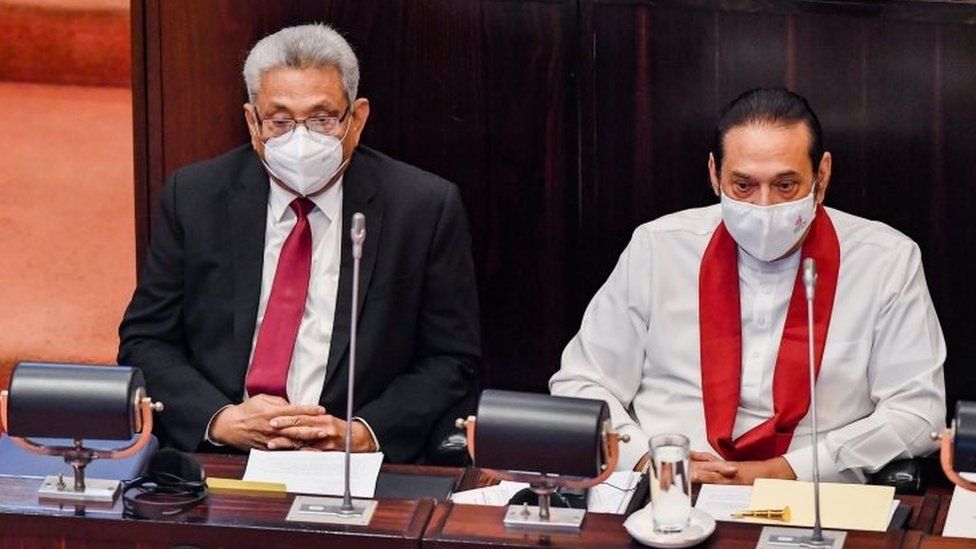 IMAGE SOURCE,EPA
IMAGE SOURCE,EPASri Lankans are still reeling from the violence that has erupted. Many politicians are sheltering in safe houses or avoiding appearing in public.
“It is not at all safe, particularly for politicians on the government side,” Nalaka Godahewa, until recently media minister, told the BBC. His house was among those torched.
Mahinda Rajapaksa, once celebrated by the majority Sinhalese as a war hero for defeating the Tamil Tiger rebels, has suddenly become a villain. Many blame his supporters for targeting anti-government protesters, which then set off a chain of violent events.
The Rajapaksas have always stood together but this time their differences are out in the open. The problem appears to have started after Gotabaya asked the family patriarch Mahinda to “take one for the team” and resign.
How the family, who have dominated Sri Lankan politics for years, overcome this crisis is now an open question.

Since last month Sri Lanka has been gripped by escalating demonstrations over soaring prices and power cuts.
On Monday, government supporters clashed violently with protesters in Colombo outside Mahinda Rajapaksa’s Temple Trees residence, and then at the main protest site at Galle Face Green.
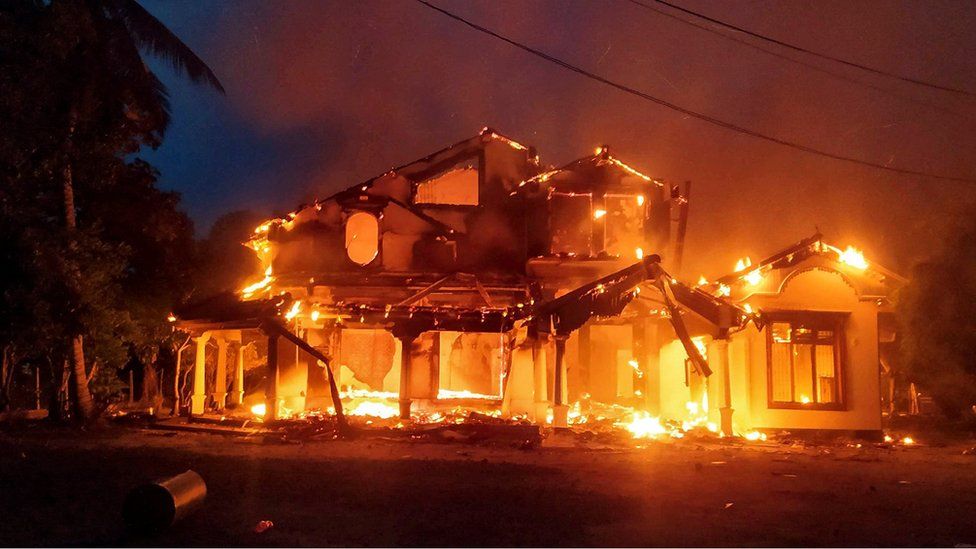 IMAGE SOURCE,REUTERS
IMAGE SOURCE,REUTERSPolice and riot squads were deployed, and tear gas and water cannon were fired at government supporters after they breached police lines and attacked protesters using sticks and poles.
Angry demonstrators retaliated, attacking government supporters and targeting ruling party MPs, including one who shot two people after a mob swarmed his car and then killed himself, according to police.
As the night went on, mobs of protesters across the country torched houses belonging to the Rajapaksas, various ministers and MPs. This included a house turned into a controversial museum by the Rajapaksas in the family’s ancestral village in Hambantota in southern Sri Lanka.
Areas near the president’s official residence were also set ablaze, according to reports. A municipal lawmaker died in hospital after an attack on his house.
Following Mahinda Rajapaksa’s resignation, protesters attempted to breach the inner compound of Temple Trees where he was staying along with several loyalists, and set fire to a bus outside the home. Police fired shots in the air and tear gas in an attempt to disperse them.
Mr Rajapaksa was flown out of Colombo to an undisclosed location on Tuesday morning.
Elsewhere in Colombo, tensions remained high. Men armed with sticks and rods had established road blocks on the routes leading to and from the airport, and police and security forces – usually a common sight in the area – were nowhere to be seen.
 IMAGE SOURCE,GETTY IMAGES
IMAGE SOURCE,GETTY IMAGESSri Lanka is facing its worst economic crisis since gaining independence from Britain in 1948, and people are furious because the cost of living has become unaffordable.
The country’s foreign currency reserves have virtually run dry, and people can no longer afford essential items including food, medicines and fuel.
The government has requested emergency financial help. It blames the Covid pandemic, which all but killed off Sri Lanka’s tourist trade – one of its biggest foreign currency earners.
But many experts say economic mismanagement is also to blame.
Mahinda Rajapaksa: Sri Lankan PM resigns amid economic crisis
Sri Lanka’s Prime Minister Mahinda Rajapaksa has resigned amid mass protests at the government’s handling of a deepening economic crisis.
The move came as the island was placed under curfew after violent clashes between Rajapaksa supporters and anti-government protesters in Colombo.
Five people have died, including a ruling party MP, and more than 190 injured in violence in the capital.
There have been protests over soaring prices and power cuts since last month.
The island nation is facing its worst economic crisis since gaining independence from Britain in 1948.
Mr Rajapaksa, 76, sent his resignation letter to his younger brother President Gotabaya Rajapaksa, saying he hoped it would help resolve the crisis, but the move is highly unlikely to satisfy government opponents while the latter remains in power.
A partial victory for protesters
In a nation facing a crisis of economic uncertainty, Mahinda Rajapaksa’s resignation was no surprise. There had been days of speculation he’d go – after reports his brother had told him he needed to quit.
In the last few days Mahinda Rajapaksa held on, with the view that as the more popular of the brothers, he shouldn’t be the one to go – but in the end he was.
Before he said goodbye, he addressed his loyal supporters at a rally in the morning – some of them were later seen attacking anti-government protesters.
As news of the PM’s departure reached Colombo’s sea front promenade, Galle Face Green, demonstrators danced with glee. For weeks they’ve been demanding the Rajapaksa family, which has ruled on and off for decades, resign.
But this is seen as just a partial victory – their real target is the president. He shows no signs of quitting, which means the protests will continue.

On Monday night AFP news agency reported that shots had been fired inside the grounds of the prime minister’s residence as police struggled to stop protesters from getting inside the inner security ring of the home where Mr Rajapaksa is holed up with some loyalists.
Earlier, police and army riot squads were deployed following violence outside the prime minister and president’s offices in Colombo. Police fired tear gas and water cannon at hundreds of ruling party supporters after they breached police lines and attacked anti-government protesters using sticks and poles.
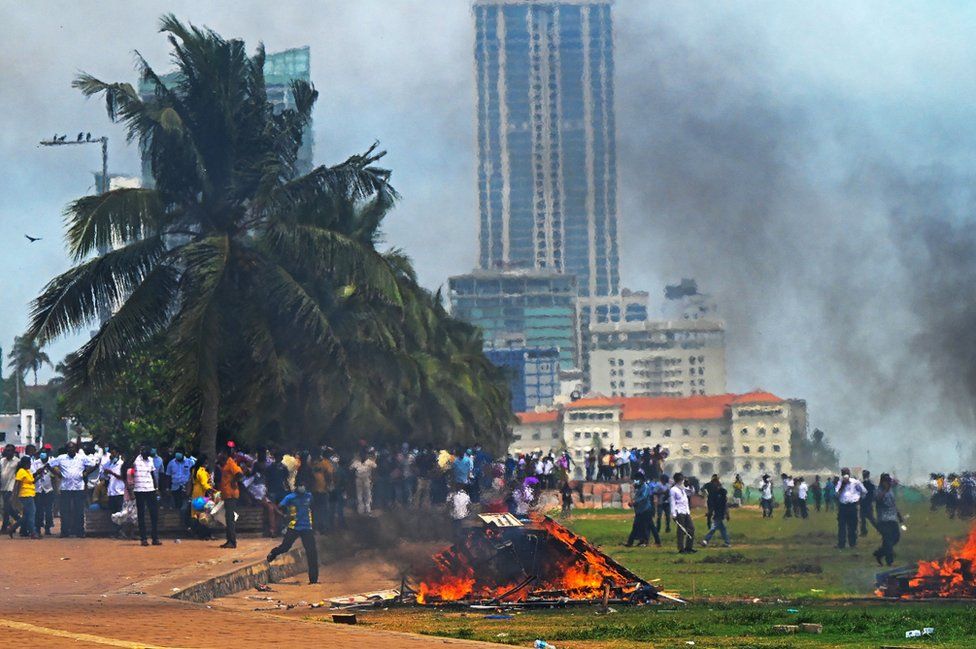 IMAGE SOURCE,AFP
IMAGE SOURCE,AFPAfter pulling down tents of protesters outside the PM’s Temple Trees residence, the Rajapaksa supporters then stormed the nearby “Gota go home” camp on the promenade.
“We were hit, the media were hit, women and children were hit,” one witness said.
Just outside the capital in the town of Nittambuwa, police said thousands of protesters surrounded the car of an MP from the governing party. He opened fire, killing one man. The MP himself was later found dead, as was his bodyguard, police told AFP.
Another MP in the southern town of Weeraketiya also opened fire on protesters at his house, killing two and wounding five others.
Mobs set fire to several properties of ruling party politicians and local government officials were attacked, according to reports.
Since demonstrations erupted in early April, protesters have been camped noisily but peacefully outside President Rajapaksa’s office at Galle Face Green, demanding he quit.
People are furious because the cost of living has become unaffordable.
Sri Lanka’s foreign currency reserves have virtually run dry, and it can no longer afford essential items including food, medicines and fuel.
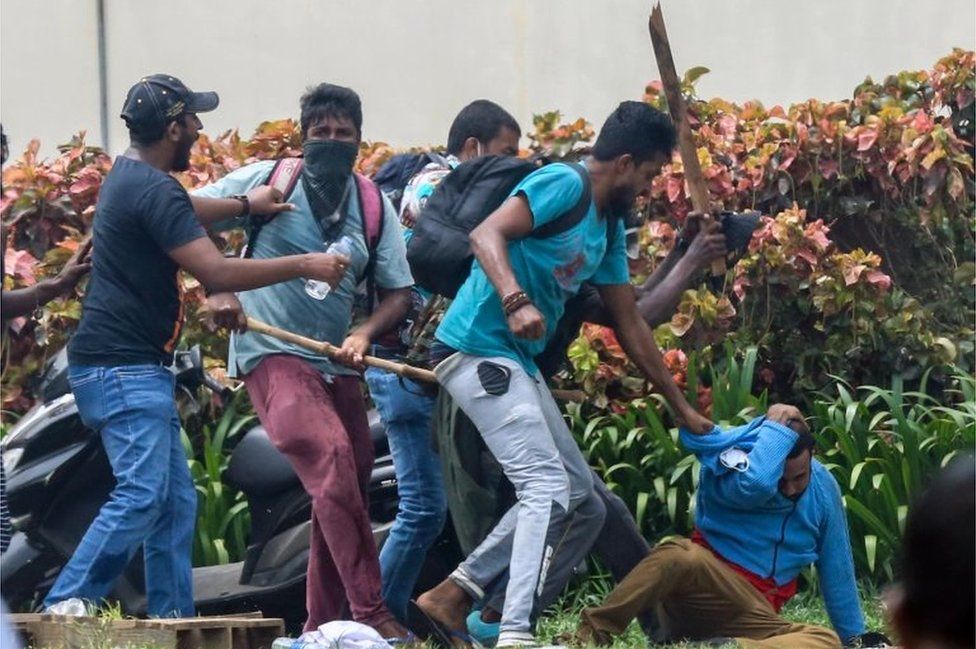 IMAGE SOURCE,EPA
IMAGE SOURCE,EPAThe government has requested emergency financial help. It blames the Covid pandemic, which all but killed off Sri Lanka’s tourist trade – one of its biggest foreign currency earners.
But many experts say economic mismanagement is to blame.
The prime minister’s letter said his resignation was intended to clear the way for an “all-party government to guide the country out of the current economic crisis”, AFP reports.
Opposition parties have so far refused to do so and have also called on the president to quit.
Humiliating exit after years in power
Mahinda Rajapaksa’s resignation marks an ignominious change in fortune for a man who for years was simply Sri Lanka’s most powerful person.
His decade as president saw him oversee the crushing of the Tamil Tiger rebels in 2009, but he was dogged by allegations of serious human rights abuses, as well as claims – which he strenuously denies – that he was corrupt while in power.
He was denied a third term as president in 2015. But less than five years later he was back – although this time as prime minister, serving as the right-hand man of younger brother Gotabaya.
The allegations of corruption have added fuel to the current protests – many people believe Mahinda Rajapaksa paved the way for his family to plunder the country’s wealth for their own financial gain.
Billboards and chants demanding the family return the country’s “stolen money” are a common sight at the protests across Sri Lanka.
Sri Lanka crisis: Pro-government supporters attack protesters in Colombo
Sri Lanka is under nationwide curfew after ruling party supporters attacked crowds protesting at the government’s handling of the economic crisis.
At least 20 people were injured in the violence outside the prime minister and president’s offices in Colombo.
Police fired tear gas and water cannon at government supporters after they breached police lines and attacked people using sticks and poles.
Soaring prices and power cuts have led to mass protests since last month.
According to a local hospital, at least 78 people have been injured in Monday’s violence.
The island nation is facing its worst economic crisis since gaining independence from Britain in 1948.
The government has requested emergency financial help. Many Sri Lankans want President Gotabaya Rajapaksa to go.
Categories
- Breaking News (148)
- buisness (21)
- Entertainment (108)
- Box Office (13)
- Gaming (10)
- Marvel (MCU) (8)
- Movies (24)
- DC (DCU) (3)
- Netflix Series (2)
- Series (6)
- Enviornment (8)
- Fashion (96)
- Men's Fashion (3)
- Women's Style (3)
- Food (13)
- Health & Fitness (9)
- History (1)
- Hollywood Gossip (3)
- Home & Garden (3)
- International News (116)
- Lifehacks (21)
- Literature (30)
- Local News (75)
- Modeling (1)
- Music (8)
- Politics (10)
- Science (37)
- Psychology (2)
- Social (3)
- Sports (106)
- Technology (31)
- Traveling (70)
- Uncategorized (64)
- Vehicles (136)
Ask Your Problems
-
About Leasing
7 years, 2 months ago
-
About Vehicles
7 years, 2 months ago











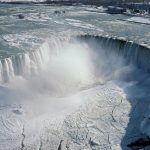
Most commented